North American Caballines and Amerhippines of the Past 1 Million Years (Part 1)
Abstract
1. Introduction
2. Preliminaries
2.1. Material
2.2. Methods of Description and Classification
2.2.1. Cranial Morphology
2.2.2. Lower Cheek Teeth Morphological Types (Figure 3)

2.2.3. Upper Cheek Teeth Morphological Types (Figure 3)
2.2.4. Limb Bones
2.2.5. Morphological Characters and Species Determination
2.3. Techniques
2.3.1. Scatter Diagrams
2.3.2. Simpson’s Diagrams
2.4. Abbreviations
2.5. Chronostratigraphic Framework
3. Distinction Between Caballine and Amerhippine Equus
3.1. Conceptual Framework and Assumptions
3.1.1. Cranial Proportions and the Discrimination of Caballine Equids
3.1.2. Taxonomical Remarks
3.1.3. Evolutionary Relationship Between Caballine and Amerhippine Equus
3.2. Observations
3.2.1. Cranial Proportions of Caballine and Amerhippine Equus and the Particular Case of Equus (H.) mexicanus
3.2.2. Upper and Lower Cheek Teeth
3.2.3. Lower Incisors
3.2.4. Metapodials
3.3. Comments
4. North American Caballines
4.1. Well-Represented North American Caballines
4.1.1. Equus (E.) scotti Gidley, 1900 [34]
- -
- A large skull broken in two fragments (UMMNH 46899a and b; Supplementary Table S1) from the Seymour Formation, Texas, referred to E. (E.) scotti by [41]. The Franck’s Index cannot be evaluated, but the Palatal Index is caballine. The upper dentition of another specimen (UMMNH 46898) illustrated by these authors can also be easily referred to E. (E.) scotti.
- -
- Eisenmann ([11,42], Figure 60 in [11]) referred to E. (E.) scotti a very well-preserved skull (Supplementary Table S1) collected at Ulakhan Bet Sular, along the Adycha River (affluent of the Iana, northern Siberia). It is preserved at the Severtsov Institute of Moscow as N° 160-455 (ex “Bet 55”). Size, proportions, and location of the posterior palatine foramen are very close to E. (E.) scotti, but the frontal region is flat instead of bulging. Both Franck’s and Palatal indices are caballine. The upper cheek teeth also resemble those of E. (E.) scotti; the lowers are not known. According to Sher (personal communication), it comes from magneto-positive deposits probably inside the lower Brunhes. Many large metapodials collected by Sher at Chukochya and Adycha may also be referred to E. (E.) scotti.
4.1.2. Equus (E.) alaskae and Equus (E.) lambei (Supplementary File S2, Supplementary Table S2)
- -
- Equus (E.) alaskae Hay, 1913b, type: cranium of a young male, USNM 7700 (Figure 17), from Sullivan’s Creek, Tofty, Central Alaska, described as E. niobrarensis alaskae [45]. The muzzle is rather long relative to the palate (Supplementary File S18).
- -
4.1.3. Comments on E. (E.) scotti, E. (E.) alaskae, and E. (E.) lambei
4.2. Hay Springs Sheridan Equus Beds Caballines
4.2.1. Crania (Supplementary Files S3 and S26, Supplementary Table S3)
- -
- USNM 4999, skull, type of Equus (E.) niobrarensis.
- -
- -
- UNSM 1346, fragmentary juvenile skull; referred to E. niobrarensis by [7].
- -
- -
4.2.2. Dentition
4.2.3. Limb Bones
4.2.4. Comments of Hay Springs Sheridan Equus Beds Caballines
4.3. Hay Springs-like Fossils
4.4. Caballine Equus from Fort Qu’Appelle (Supplementary File S3, Supplementary Table S4)
4.5. Equus (E.) pacificus Leidy, 1868 (Figure 31)

4.6. Equus (E.) complicatus Leidy, 1858 [59], (Figure 32)

4.7. Equus holmesi Hay, 1920 [65]
4.8. Equus laurentius Hay, 1913a [62] (Supplementary Table S4)
4.9. Summary
- -
- The best documented and most ancient North American caballine species, Equus (E.) scotti, was about the size of an Arabian horse but had heavier bones, wider third phalanges, and less cursorial limb bone proportions (see comparison of limb proportions in Section 6.2.). Its weight may be estimated at 500–600 kg [56]. The maximal observed metapodial distal breadth is 59 mm, and the longest MC and MT are 246 and 291 mm long, respectively. The basilar skull length is 530 to 600 mm.
- -
- The later E. (E.) niobrarensis was slightly smaller but probably had the same limb proportions; it differs, however, by cranial and dental features. The horse from Fort Qu’Appelle may be referred to E. (E.) niobrarensis, and the western E. (E.) pacificus may be related to E. (E.) niobrarensis, but this needs to be evaluated further.
- -
- The juvenile cranium UNSM 1346 from Hay Springs belongs to a caballine, but it is unique compared to other North American caballine crania we studied by its large size and the long distance between basion and staphylion; we refer to it as Equus (E.) sp. We also refer to Equus (E.) sp. the large cranium UNSM 5989 also recovered from Hay Springs.
- -
- Both E. (E.) alaskae and E. (E.) lambei primarily inhabited Yukon, Alaska, and NE Siberia during the Late Pleistocene. They both were about the size of E. (E.) przewalskii but with heavier bones. The associated limb bones FAM 71467 from Fox 33 and (not certainly associated) from Natural Trap Cave have the same relative lengths as E. (E.) scotti. Basilar lengths of fossil skulls of E. (E.) alaskae and E. (E.) lambei are similar (averages of 489 mm and 483 mm). Metapodial distal breadths measured 42 to 47 mm in both E. (E.) lambei and E. (E.) alaskae. The cranial proportions (Figure 25) differ only by the muzzle length and breadth: E. (E.) lambei crania have shorter and broader muzzles probably adapted to cold conditions according to Allen’s rule; it is remarkable that there are no intermediate morphologies. We hypothesize that E. (E.) alaskae and E. (E.) lambei are “ecological variants” of a single species.
- -
- Equus (E.) complicatus was a large form, probably restricted to southeastern North America. Unfortunately, only its upper and lower cheek teeth are well documented.
5. Equus midlandensis
5.1. Equus midlandensis Holotype
5.2. Referred Specimens
- -
- Baggett Ranch, Odessa, Texas, and Clovis site, 7 miles north of Portales, New Mexico
5.3. Other Relevant Specimens
- -
- Blackwater Draw, Roosevelt County, New Mexico and Lubbock, Texas
- -
- Boatwright and Trinity River, Texas
- -
- Ingleside, Texas
5.4. Comments
6. Equus (Hesperohippus) Mexicanus
6.1. Equus (Hesperohippus) mexicanus Holotype
6.2. Referred Specimens
- -
- Tequixquiac, Estado de México
- -
- Barranca del Muerto, Estado de México
- -
- Cedazo, Aguascalientes
- -
- Cedral, San Luis Potosí
- -
- Río Sabinal, Oaxaca
- A partial cranium from Oaxaca State, Mexico, referred to E. mexicanus (UMPE 521) by ([23], Figure 4-A) has basicranial proportions that are different from the holotype of E. (H.) mexicanus (Supplementary Files S8 and S9). In fact, UMPE 521 (Figure 46) is similar to specimens of E. (A.) occidentalis (Supplementary File S42) and its cheek teeth also show the morphology observed in this species (Figure 46); UMPE 521 may be referred to E. (A.) occidentalis.
- The enamel pattern of the partial mandible UMPE 554 from Oaxaca ([23], Figure 4-B and C) is very perplexing. In addition to caballine patterns on other teeth, a non-caballine bridge affects the p4 (Figure 45). We have already commented on this kind of “bridge” (Figure 3); let us just stress that we have never seen one so pronounced in association with caballine double knots.
- -
- Other referrals
6.3. Taxonomic Remarks
7. General Conclusions
Supplementary Materials
Author Contributions
Funding
Data Availability Statement
Acknowledgments
Conflicts of Interest
References
- Gidley, J.W. Tooth characters and revision of the North American species of the genus Equus. Bull. Am. Mus. Nat. Hist. 1901, 14, 91–142. [Google Scholar]
- Savage, D.E. Late Cenozoic Vertebrates of the San Francisco Bay Region; University of California Publications, Bulletin of the Department of Geological Sciences; University of California Press: Berkeley, CA, USA, 1951; Volume 28, pp. 215–314. [Google Scholar]
- Quinn, J.H. Pleistocene Equidae of Texas; Bureau of Economic Geology, The University of Texas at Austin, Bureau of Economic Geology, Report of Investigations; The University of Texas: Austin, TX, USA, 1957; No. 33; p. 51. [Google Scholar]
- Dalquest, W.W. Phylogeny of American horses of Blancan and Pleistocene age. Acta Zool. Fenn. 1978, 15, 191–199. [Google Scholar]
- Bennett, D.K. Stripes do not a zebra make. Part I: A cladistic analysis of Equus. Syst. Zool. 1980, 29, 272–287. [Google Scholar] [CrossRef]
- Winans, M.C. A quantitative study of North American fossil species of the genus Equus. In The Evolution of Perissodactyls; Prothero, D.R., Schoch, R.M., Eds.; Oxford University Press: Oxford, UK, 1989; pp. 263–297. [Google Scholar]
- Azzaroli, A. The genus Equus in North America. The Pleistocene species. Palaeontogr. Ital. 1998, 85, 1–60. [Google Scholar]
- Cirilli, O.; Machado, H.; Arroyo-Cabrales, J.; Barrón-Ortiz, C.I.; Davis, E.; Jass, C.N.; Jukar, A.M.; Landry, Z.; Marín-Leyva, A.H.; Pandolfi, L.; et al. Evolution of the family Equidae, subfamily Equinae, in North, Central and South America, Eurasia and Africa during the Plio-Pleistocene. Biology 2022, 11, 1258. [Google Scholar] [CrossRef]
- Eisenmann, V.; Baylac, M. Extant and fossil Equus (Mammalia, Perissodactyla) skulls: A morphometric definition of the subgenus Equus. Zool. Scr. 2000, 29, 89–100. [Google Scholar] [CrossRef]
- Eisenmann, V. Discriminating Equus skulls: The Franck’s Index and the new Palatal Index. In Equids in Time and Space, Proceedings of the 9th ICAZ Conference, Durham, UK, 23–28 August 2002; Mashkour, M., Ed.; Oxbow Books: Oxford, UK, 2006; pp. 172–182. [Google Scholar]
- Eisenmann, V. Old World Fossil Equus (Perissodactyla, Mammalia), Extant Wild Relatives and incertae sedis forms. Quaternary 2022, 5, 38. [Google Scholar] [CrossRef]
- Barrón-Ortiz, C.I.; Avilla, L.S.; Jass, C.N.; Bravo-Cuevas, V.M.; Machado, H.; Mothé, D. What is Equus? Reconciling taxonomy and phylogenetic analyses. Front. Ecol. Evol. 2019, 7, 343. [Google Scholar] [CrossRef]
- Cirilli, O.; Pandolfi, L.; Rook, L.; Bernor, R.L. Evolution of Old World Equus and origin of the zebra-ass clade. Sci. Rep. 2021, 11, 10156. [Google Scholar] [CrossRef] [PubMed]
- Orlando, L.; Male, D.; Alberdi, M.T.; Prado, J.L.; Prieto, A.; Cooper, A.; Hänni, C. Ancient DNA clarifies the evolutionary history of American Late Pleistocene equids. J. Mol. Evol. 2008, 66, 533–538. [Google Scholar] [CrossRef]
- Orlando, L.; Ginolhac, A.; Zhang, G.; Froese, D.; Albrechtsen, A.; Stiller, M.; Schubert, M.; Cappellini, E.; Petersen, B.; Moltke, I.; et al. Recalibrating Equus evolution using the genome sequence of an early Middle Pleistocene horse. Nature 2013, 499, 74–78. [Google Scholar] [CrossRef]
- Barrón-Ortiz, C.I.; Rodrigues, A.T.; Theodor, J.M.; Kooyman, B.P.; Yang, D.Y.; Speller, C.F. Cheek tooth morphology and ancient mitochondrial DNA of late Pleistocene horses from the western interior of North America: Implications for the taxonomy of North American Late Pleistocene Equus. PLoS ONE 2017, 12, e0183045. [Google Scholar] [CrossRef]
- Eisenmann, V. Sussemionus, a new subgenus of Equus (Perissodactyla, Mammalia). Comptes Rendus Biol. 2010, 333, 235–240. [Google Scholar] [CrossRef]
- Cucchi, T.; Mohaseb, A.; Peigné, S.; Debue, K.; Orlando, L.; Mashkour, M. Detecting taxonomic and phylogenetic signals in equid cheek teeth: Towards new palaeontological and archaeological proxies. R. Soc. Open Sci. 2017, 4, 160997. [Google Scholar] [CrossRef] [PubMed]
- Mohaseb, A.; Cornette, R.; Zimmermann, M.; Davoudi, H.; Berthon, R.; Guintard, C.; Cucchi, T.; Hanot, P.; Mohandesan, E.; Eisenmann, V.; et al. Predictive use of modern reference osteological collections for disentangling the shape of Eurasian equid cheek teeth and metapodials in archaeological material. Int. J. Osteoarchaeol. 2023, 33, 938–954. [Google Scholar] [CrossRef]
- Grass, A.; Jones, J.; Campbell, A.; Higgins, P.; Meachen, J. A geometric evaluation of equid tooth shape at Natural Trap Cave, Wyoming. Quat. Int. 2023, 647–648, 94–102. [Google Scholar] [CrossRef]
- Simpson, G.G. Large Pleistocene felines of North America. In American Museum Novitates; The American Museum of Natural History New York City: New York, NY, USA, 1941; No. 1136; pp. 1–27. [Google Scholar]
- Oakenfull, E.A.; Lim, H.N.; Ryder, O.A. A survey of equid mitochondrial DNA: Implications for the evolution, genetic diversity, and conservation of Equus. Genetica 2000, 1, 341–355. [Google Scholar] [CrossRef]
- Jiménez-Hidalgo, E.; Carbot-Chanona, G.; Guerrero-Arenas, R.; Bravo-Cuevas, V.M.; Holdridge, G.S.; Israde-Alcántara, I. Species diversity and paleoecology of Late Pleistocene horses from southern Mexico. Front. Ecol. Evol. 2019, 7, 394. [Google Scholar] [CrossRef]
- Boddaert, P. Elenchus Animalium, Volumen 1: Sistens Quadrupedia huc Usque Nota, Erorumque Varietates; C.R. Hake: Rotterdam, The Netherlands, 1785; 174p. [Google Scholar]
- Gromova, V.I. O skelete tarpana (Equus caballus gmelini Ant.) i drugikh sovremennykh dikikh loshadej. (Chast’1). Byulleten’ Mosk. Obs. Ispyt. Prir. Otd. Biol. 1959, 64, 99–124. (In Russian) [Google Scholar]
- Gentry, A.; Clutton Brock, J.; Groves, C. Proposed conservation of usage of 15 mammal specific names based on wild species which are antecedent or contemporary with those based on domestic animals. Bull. Zool. Nomencl. 1996, 55, 28–37. [Google Scholar] [CrossRef]
- Steklenev, E.P. Species differences in sperma of the Equidae Family in connection with their hybridization. [In Russian. Vidovye razlichija spermiev predstavitelej semesjstva loshadinykh (Equidae) vsvazi s ikh gibridizatsiej]. Cytol. Genet. Tsitologia i Genetika 1972, 6, 338–344. [Google Scholar]
- Weinstock, J.; Willerslev, E.; Sher, A.; Thong, W.; Ho, S.Y.W.; Rubenstein, D.; Storer, J.; Burns, J.; Martin, L.; Bravi, C.; et al. Evolution, systematics, and phylogeography of Pleistocene horses in the New World: A molecular perspective. PLoS Biol. 2005, 3, e241. [Google Scholar] [CrossRef]
- Hibbard, C. Pleistocene vertebrates from the Upper Becerra (Becerra Superior) Formation, Valley of Tequixquiac, Mexico, with notes on other Pleistocene forms. Paleontol. Contrib. Mich. Univ. Mus. 1955, 12, 47–96. [Google Scholar]
- Dalquest, W.W. Mammals of the Pleistocene Slaton local fauna of Texas. Southwest. Nat. 1967, 12, 1–30. [Google Scholar] [CrossRef]
- Eisenmann, V. Le protostylide: Valeur systématique et signification phylétique chez les espèces actuelles et fossiles du genre Equus (Perissodactyla, Mammalia). Z. Saugetierkd. 1976, 41, 349–365. [Google Scholar]
- Hoffstetter, R. Algunas observaciones sobre los caballos fósiles de la América del Sur Amerhippus gen. nov. Boletín Inf. Científicas Nac. 1950, 3, 426–454. [Google Scholar]
- Eisenmann, V. Etude des cornets des dents incisives inférieures des Equus actuels et fossils. Palaeontogr. Ital. 1979, 71, 55–75. [Google Scholar]
- Gidley, J.W. A new species of Pleistocene horse from the Staked Plains of Texas. Bull. Am. Mus. Nat. Hist. 1900, 13, 111–116. [Google Scholar]
- Kurten, B.; Anderson, E. Pleistocene Mammals of North America; Columbia University Press: New York, NY, USA, 1980; 442p. [Google Scholar]
- Lundelius, E.L., Jr.; Churcher, C.R.; Downs, T.; Harington, C.R.; Lindsay, E.H.; Schultz, G.E.; Semken, H.A.; Webb, S.D.; Zakrzewski, R.J. The North American Quaternary sequence. In Cenozoic Mammals of North America. Geochronology and Biostratigraphy; Woodburne, M.O., Ed.; University of California Press: Berkeley, CA, USA, 1987; pp. 211–235. [Google Scholar]
- Repenning, C.A. Biochronology of the microtine rodents of the United States. In Cenozoic Mammals of North America. Geochronology and Biostratigraphy; Woodburne, M.O., Ed.; University of California Press: Berkeley, CA, USA, 1987; pp. 236–268. [Google Scholar]
- Gazin, C.L. A study of fossil horse remains from the Upper Pliocene of Idaho. Proc. U. S. Natl. Mus. 1936, 84, 281–320. [Google Scholar] [CrossRef]
- Hay, O.P. The Pleistocene mammals of Iowa. Ann. Rep. Iowa Geol. Surv. 1914, 23, 1–494. [Google Scholar] [CrossRef]
- Johnston, C.S. Notes on the craniometry of Equus scotti Gidley. J. Paleontol. 1937, 11, 459–461. [Google Scholar]
- Hibbard, C.W.; Dalquest, W.W. Fossils from the Seymour Formation of Knox and Baylor Counties Texas, and their bearing of the Late Kansan Climate of that region. Paleontol. Contrib. Mich. Univ. Mus. 1966, 21, 1–66. [Google Scholar]
- Eisenmann, V. Origins, dispersals, and migrations of Equus (Mammalia, Perissodactyla). Cour. Forschinst Senckenb 1992, 153, 161–170. [Google Scholar]
- Alberdi, M.T.; Arroyo-Cabrales, J.; Marín-Leyva, A.H.; Polaco, O.J. Study of Cedral horses and their place in the Mexican Quaternary. Rev. Mex. Cienc. Geol. 2014, 31, 221–237. [Google Scholar]
- Priego-Vargas, J.; Bravo-Cuevas, V.M.; Jiménez-Hidalgo, E. Revisión taxonómica de los équidos del Pleistoceno de México con base en la morfología dental. Rev. Bras. Paleontol. 2017, 20, 239–268. [Google Scholar] [CrossRef]
- Hay, O.P. Description of the skull of an extinct horse, found in central Alaska. Smithson. Misc. Coll. 1913, 61, 1–21. [Google Scholar]
- Hay, O.P. Description of a new species of extinct horse, Equus lambei, from the Pleistocene of Yukon Territory. Proc. U. S. Natl. Mus. 1917, 53, 435–443. [Google Scholar] [CrossRef]
- Harington, C.R.; Clulow, F.V. Pleistocene mammals from Gold Run Creek, Yukon Territory. Can. J. Earth Sci. 1973, 10, 697–759. [Google Scholar] [CrossRef]
- Forsten, A. Equus lambei Hay, the Yukon Wild Horse, not ass. J. Mammal. 1986, 67, 422–423. [Google Scholar] [CrossRef]
- Landry, Z.; Roloson, M.J.; Fraser, D. Investigating the reliability of metapodials as taxonomic indicators for Beringian horses. J. Mamm. Evol. 2022, 29, 863–875. [Google Scholar] [CrossRef]
- Harris, A.H.; Porter, L.S.W. Late Pleistocene horses of Dry Cave, Eddy County, New Mexico. J. Mammal. 1979, 61, 46–65. [Google Scholar] [CrossRef]
- Schultz, C.B.; Tanner, L.G. Medial Pleistocene Fossil Vertebrate Localities in Nebraska. Univ. Nebraska State Mus. Bull. 1957, 4, 59–81. [Google Scholar]
- Howe, J.A. Pleistocene Equidae from Sheridan County, Nebraska. J. Paleontol. 1979, 53, 1228–1236. [Google Scholar]
- Lundelius, E.L., Jr. Fossil Vertebrates from the Late Pleistocene Ingleside Fauna, San Patricio County, Texas; Bureau of Economic Geology, Report of Investigations No. 77; University of Texas: Austin, TX, USA, 1972; pp. 1–74. [Google Scholar]
- Khan, E. Biostratigraphy and Paleontology of a Sangamon Deposit at Fort Qu’Appelle, Saskatchewan; National Museums of Canada: Gatineau, QC, Canada, 1970; Volume 5, pp. 1–82. [Google Scholar]
- Leidy, J. Notice of some remains of horses. Proc. Acad. Nat. Sci. Phila. 1868, 20, 195. [Google Scholar]
- Eisenmann, V. Gigantic Horses. In Advances in Paleontology “Hen to Panta”, Papers in Honour of C. Radulescu and P. M. Samson; Petculescu, A., Stiuca, E., Eds.; The Romanian Academy Publishing House: Bucharest, Roumania, 2003; pp. 31–40. [Google Scholar]
- Cope, E.D. A Preliminary Report on the Vertebrate Paleontology of the Llano Estacado; Geological Survey of Texas: Austin, TX, USA, 1893; pp. 1–137.
- Frick, C. Extinct Vertebrate Faunas of the Badlands of Bautista Creek and San Timoteo Canyon, Southern California; University of California Press: Berkely, CA, USA, 1921; Volume 12, pp. 277–424. [Google Scholar]
- Leidy, J. Abstract of remarks made before a meeting of the Academy of Natural Sciences of Philadelphia, March 9th, 1858. Proc. Acad. Nat. Sci. Phila. 1858, 10, 11. [Google Scholar]
- McDonald, H.G.; Scott, E. The Pleistocene Fauna of Big Bone Lick, Boone County, Kentucky: A rich history and unanswered questions. In Field Guide to Big Bone Lick, Kentucky; Hedeen, S.E., Schwalbach, C.E., Eds.; Kentucky Geological Survey: Lexington, KY, USA, 2023; pp. 30–54. [Google Scholar] [CrossRef]
- Leidy, J. On the fossil horse of America. Description of new species of Squalides from the Tertiary Beds of South Carolina. Proc. Acad. Nat. Sci. Phila. 1847, 3, 262–269. [Google Scholar]
- Hay, O.P. Notes on some fossil horses with description of four new species. Proc. U. S. Natl. Mus. 1913, 44, 569–594. [Google Scholar] [CrossRef]
- Leidy, J. Description of vertebrate fossils. In Post-Pliocene Fossils of South-Carolina; Holmes, F.S., Ed.; Russell & Jones: Charleston, WV, USA, 1860; pp. 99–122. Available online: https://www.biodiversitylibrary.org/page/12524898 (accessed on 10 November 2024).
- Leidy, J. Notice of some Mammalian remains from the Salt Mine of Petite Anse, Louisiana. Trans. Wagner Free Inst. Sci. 1889, 2, 33–40. [Google Scholar]
- Hay, O.P. Descriptions of some Pleistocene vertebrates found in the United States. Proc. U. S. Natl. Mus. 1920, 58, 1–74. [Google Scholar] [CrossRef]
- Hay, O.P.; Cook, H.J. Preliminary descriptions of fossil mammals recently discovered in Oklahoma, Texas, and New Mexico. Proc. Colo. Mus. Nat. Hist. 1928, 8, 1–33. [Google Scholar]
- Hay, O.P. The Pleistocene of the Western Region of North America and Its Vertebrated Animals; Carnegie Institution of Washington: Washington, DC, USA, 1927; No. 332; pp. 1–346. [Google Scholar] [CrossRef]
- Scott, E.; Stafford, T.W., Jr.; Graham, R.W.; Martin, L.D. Morphology and metrics, isotopes and dates: Determining the validity of Equus laurentius Hay, 1913. J. Vert. Paleontol. 2010, 30, 1840–1847. [Google Scholar] [CrossRef]
- Taylor, W.T.T.; Librado, P.; Hunska Tašunke Icu, M.; Shield, C.; Arterberry, J.; Luta Win, A.; Nujipi, A.; Omniya, T.; Gonzalez, M.; Means, B.; et al. Early dispersal of domestic horses into the Great Plains and northern Rockies. Science 2023, 379, 1316–1323. [Google Scholar] [CrossRef] [PubMed]
- Lundelius, E.L., Jr. Vertebrate remains from the Gray Sand. In Blackwater Locality No. 1: A Stratified Early Man Site in Eastern New Mexico; Hester, J.J., Ed.; Fort Burgwin Research Center Publications: Rancho de Taos, NM, USA, 1972; No. 8; pp. 148–163. [Google Scholar]
- Mooser, O. La fauna “Cedazo” del Pleistoceno en Aguascalientes. An. Inst. Biol. Univ. Nac. Auton. Mex. 1958, 29, 409–452. [Google Scholar]
- Vershinina, A.O.; Heintzman, P.D.; Froese, D.G.; Zazula, G.; Cassatt-Johnstone, M.; Dalén, L.; Der Sarkissian, C.; Dunn, S.G.; Ermini, L.; Gamba, C.; et al. Ancient horse genomes reveal the timing and extent of dispersals across the Bering Land Bridge. Mol. Ecol. 2021, 30, 6144–6161. [Google Scholar] [CrossRef]
- Slaughter, B.H.; Crook, W.W.; Harris, K.; Allen, D.C.; Seifert, M. The Hill-Shuler Local faunas of the Upper Trinity River, Dallas and Denton Counties, Texas; Bureau of Economic Geology, The University of Texas at Austin, Bureau of Economic Geology, Report of Investigations; The University of Texas: Austin, TX, USA, 1962; No. 48; p. 75. [Google Scholar]
- Carranza-Castañeda, O.; Miller, W.E. Rediscovered type specimens and other important published Pleistocene mammalian fossils from central Mexico. J. Vert. Paleont. 1987, 7, 335–341. [Google Scholar] [CrossRef]
- Cope, E.D. The extinct mammalia of the Valley of Mexico. Proc. Am. Philo. Soc. 1884, 22, 1–23. [Google Scholar]
- Villada, M.M. Acerca de la Fauna Fósil del Valle de México; Anales del Instituto Nacional de Antropología e Historia: Ciudad de México, Mexico, 1903; Volume 7, pp. 441–451. [Google Scholar]
- Mooser, O.; Dalquest, W.W. Pleistocene mammals from Aguascalientes, Central Mexico. J. Mammal. 1975, 56, 781–820. [Google Scholar] [CrossRef]
- Miller, W.E.; Pérez-Roldán, G.; Mead, J.; Gómez-Núñez, R.; Madrazo-Fanti, J.; Ortiz-Pérez, I. Post-Pleistocene horses (Equus) from México. Texas J. Sci. 2022, 74, 5. [Google Scholar] [CrossRef]
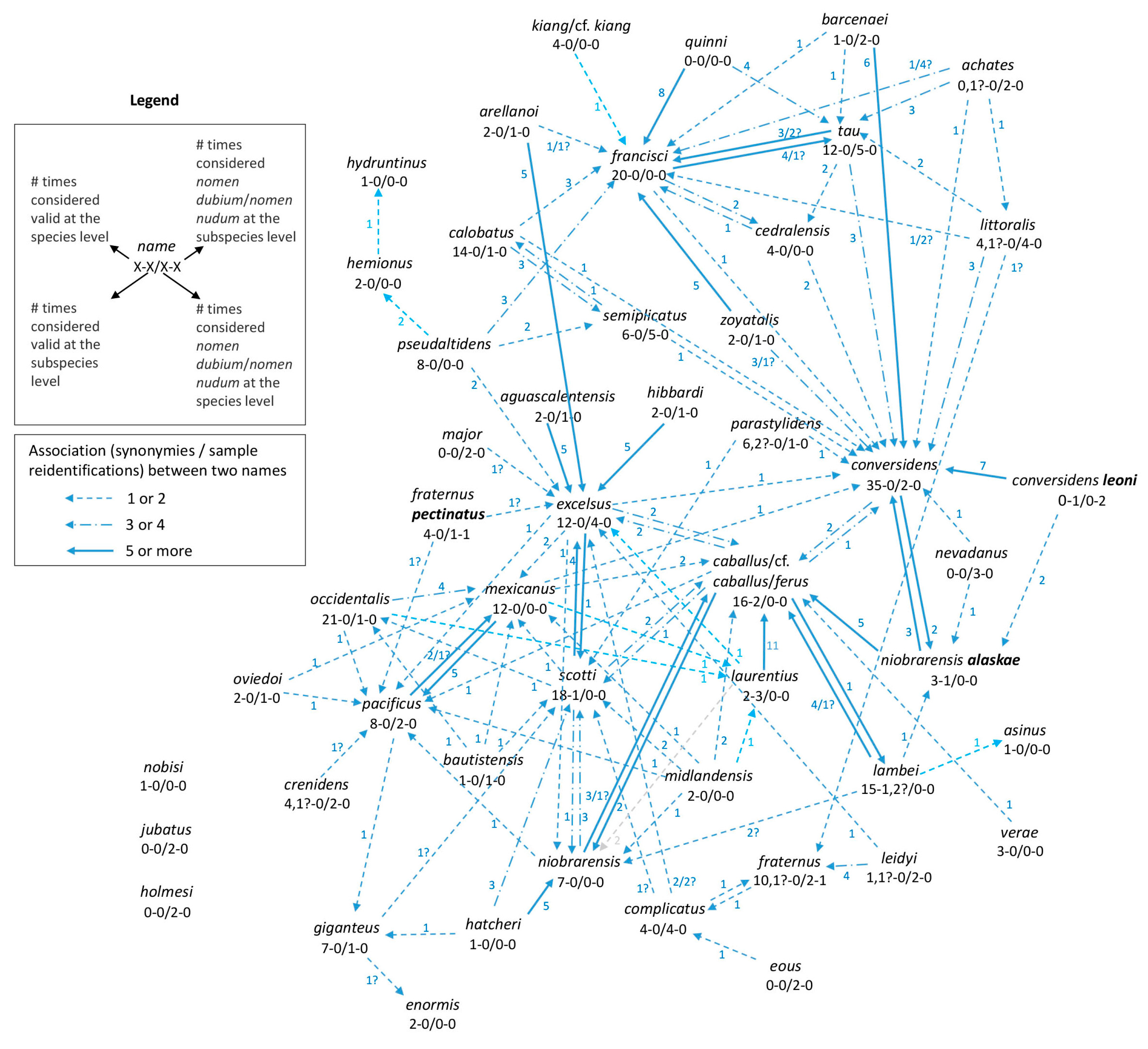
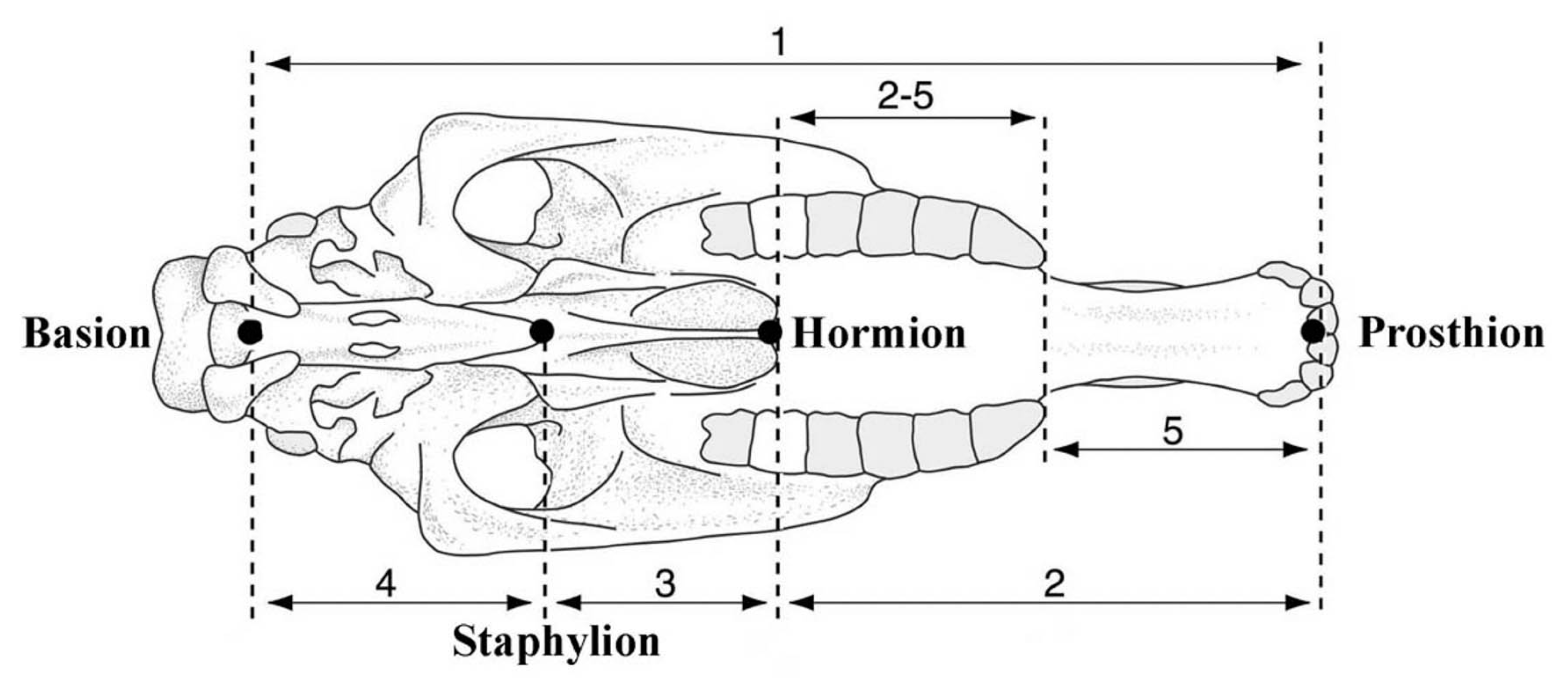


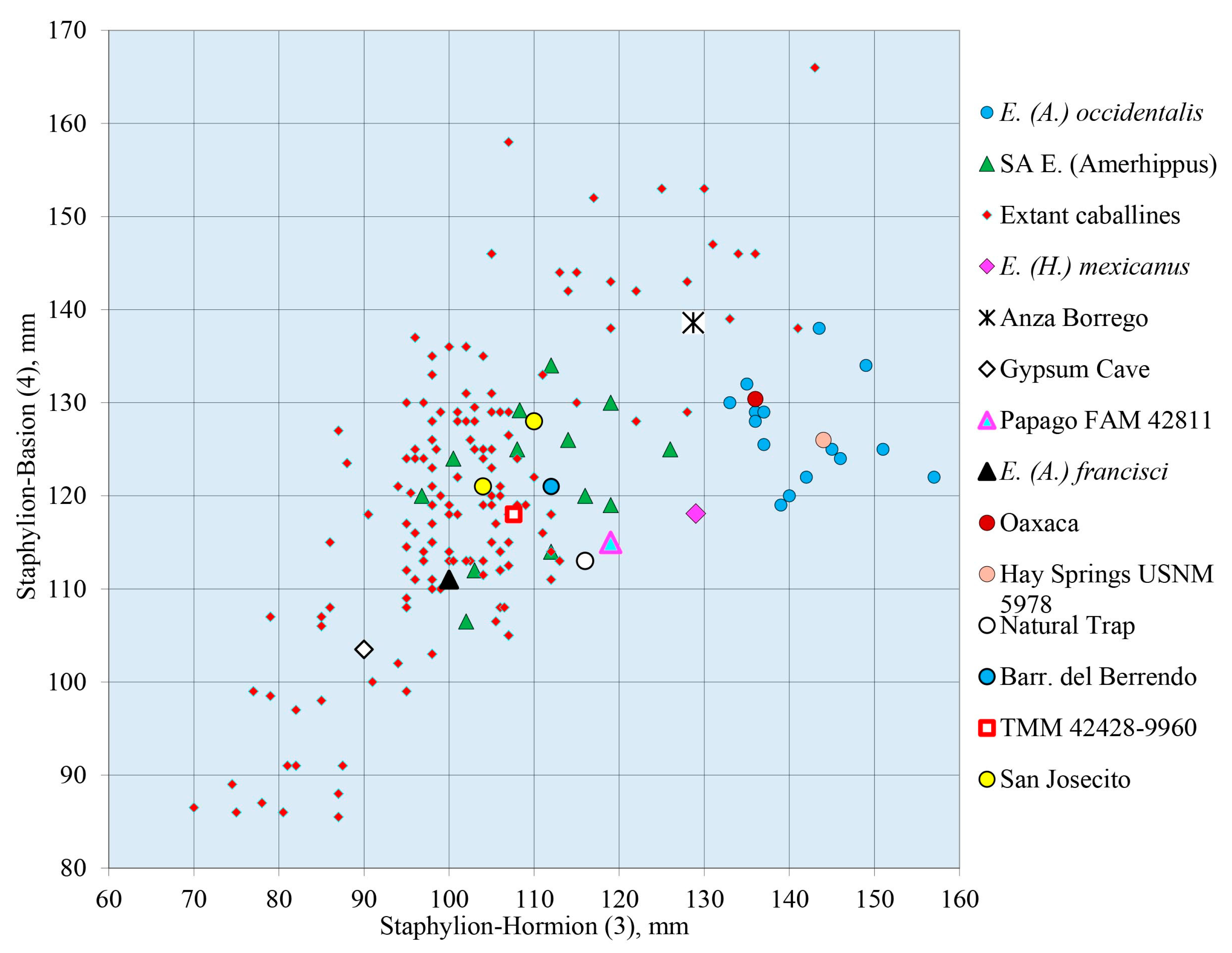

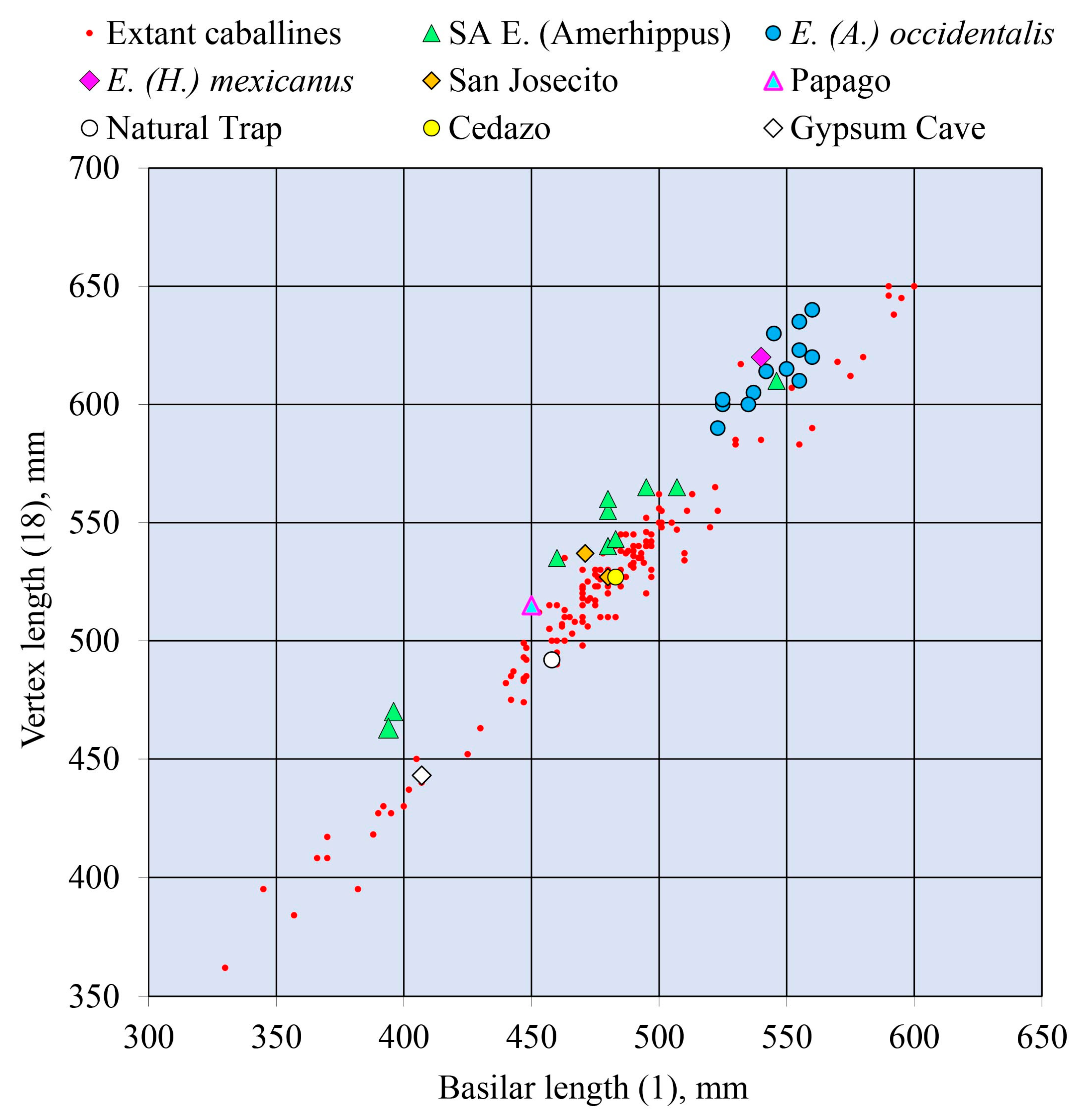










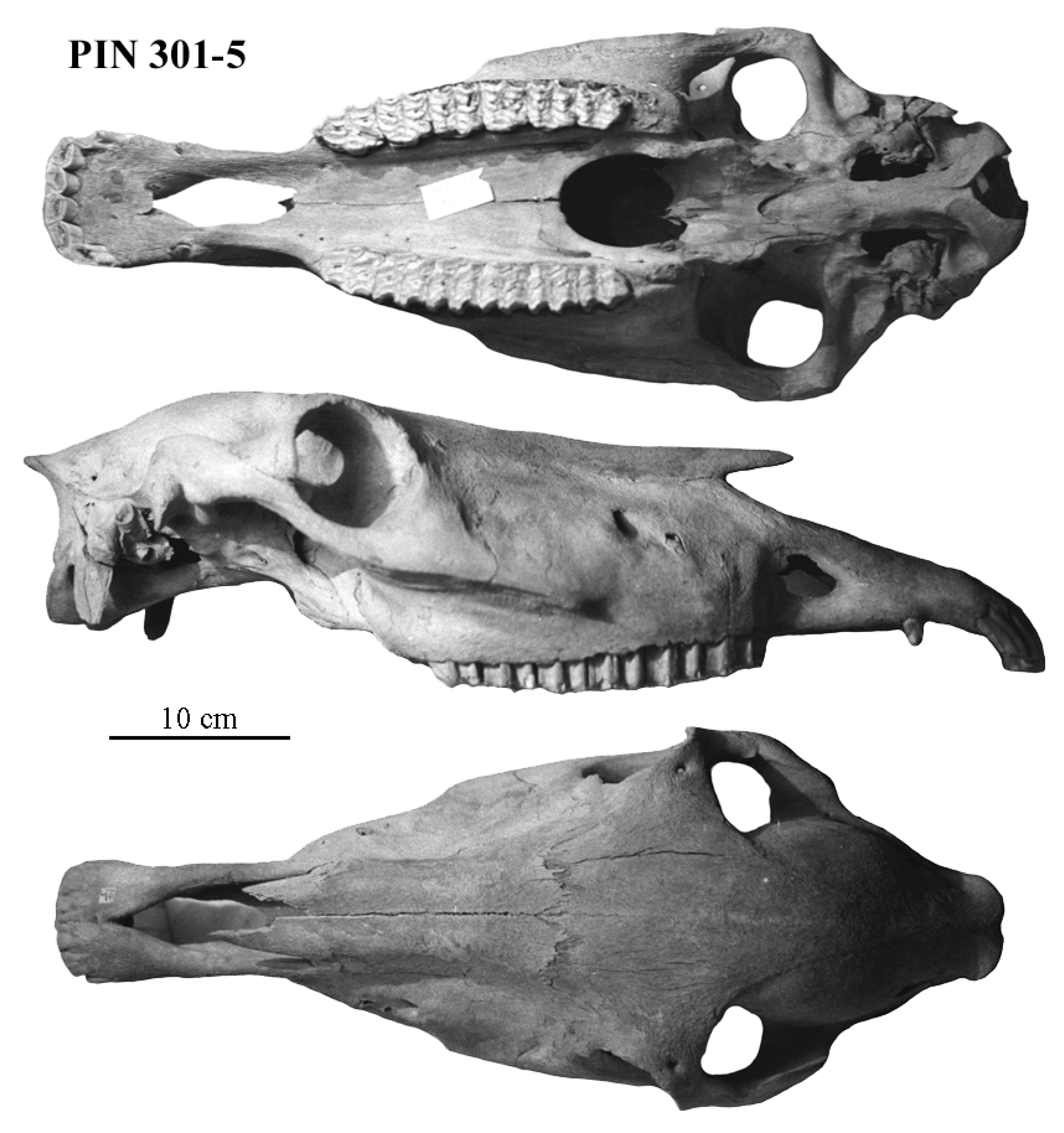





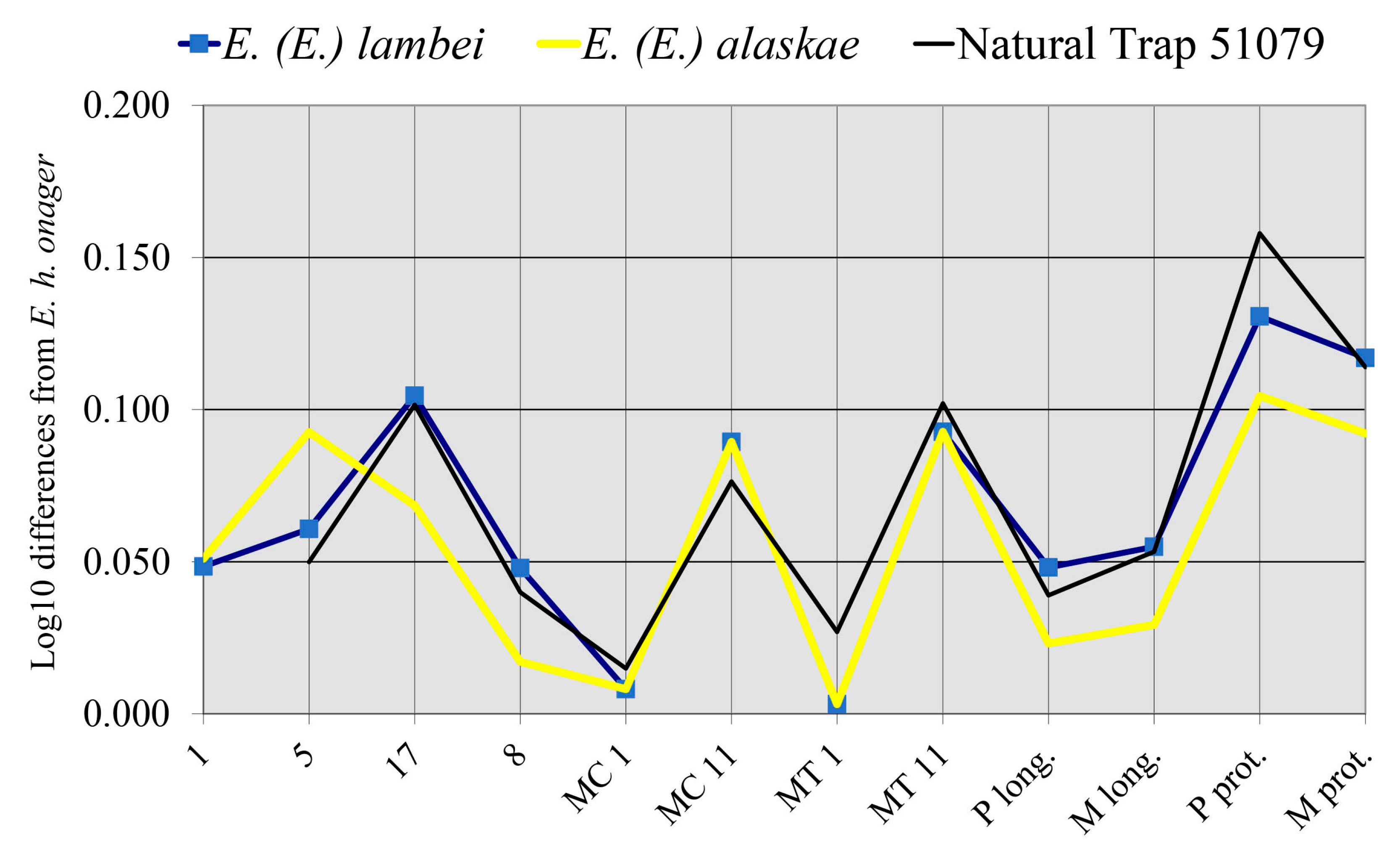

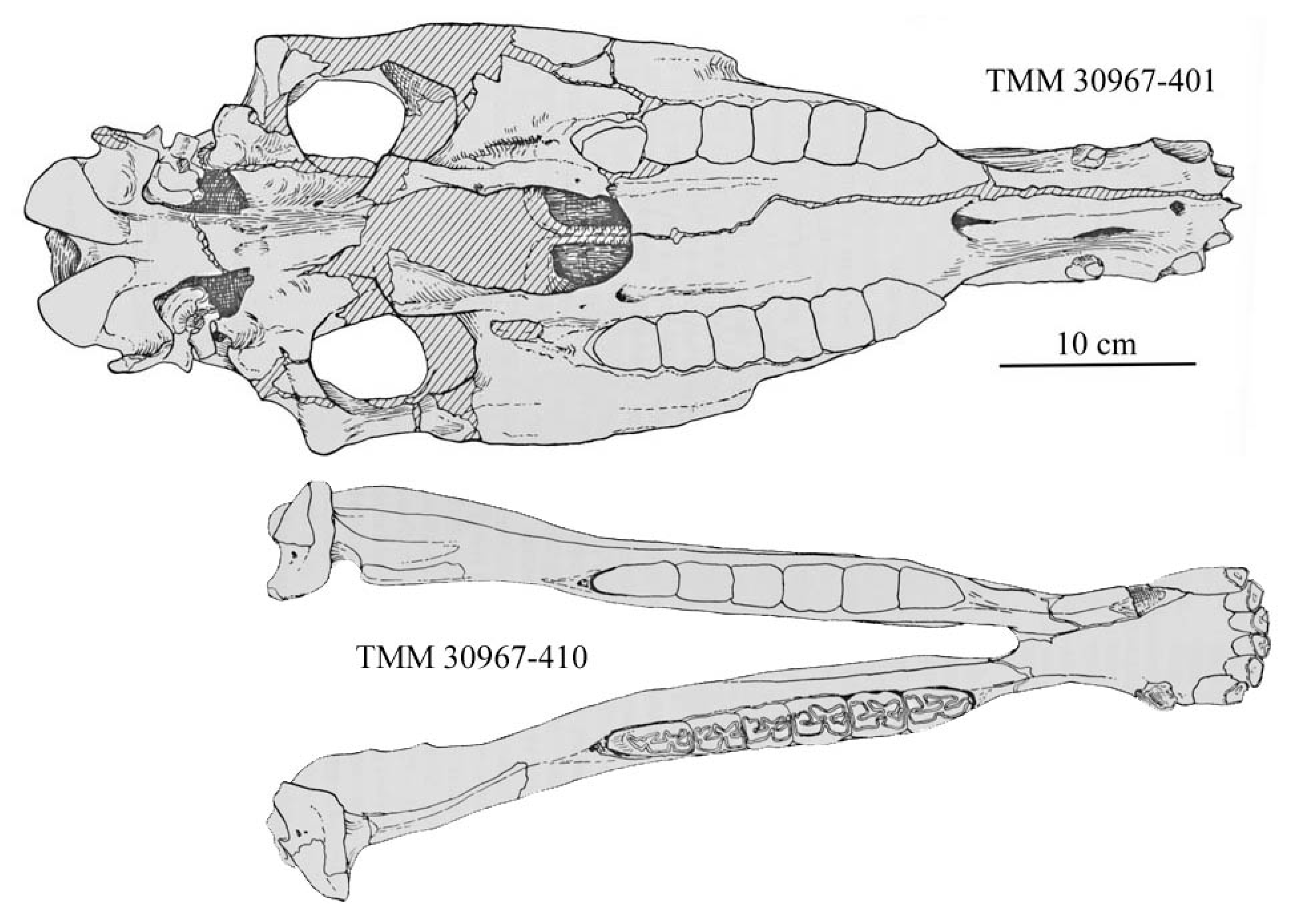





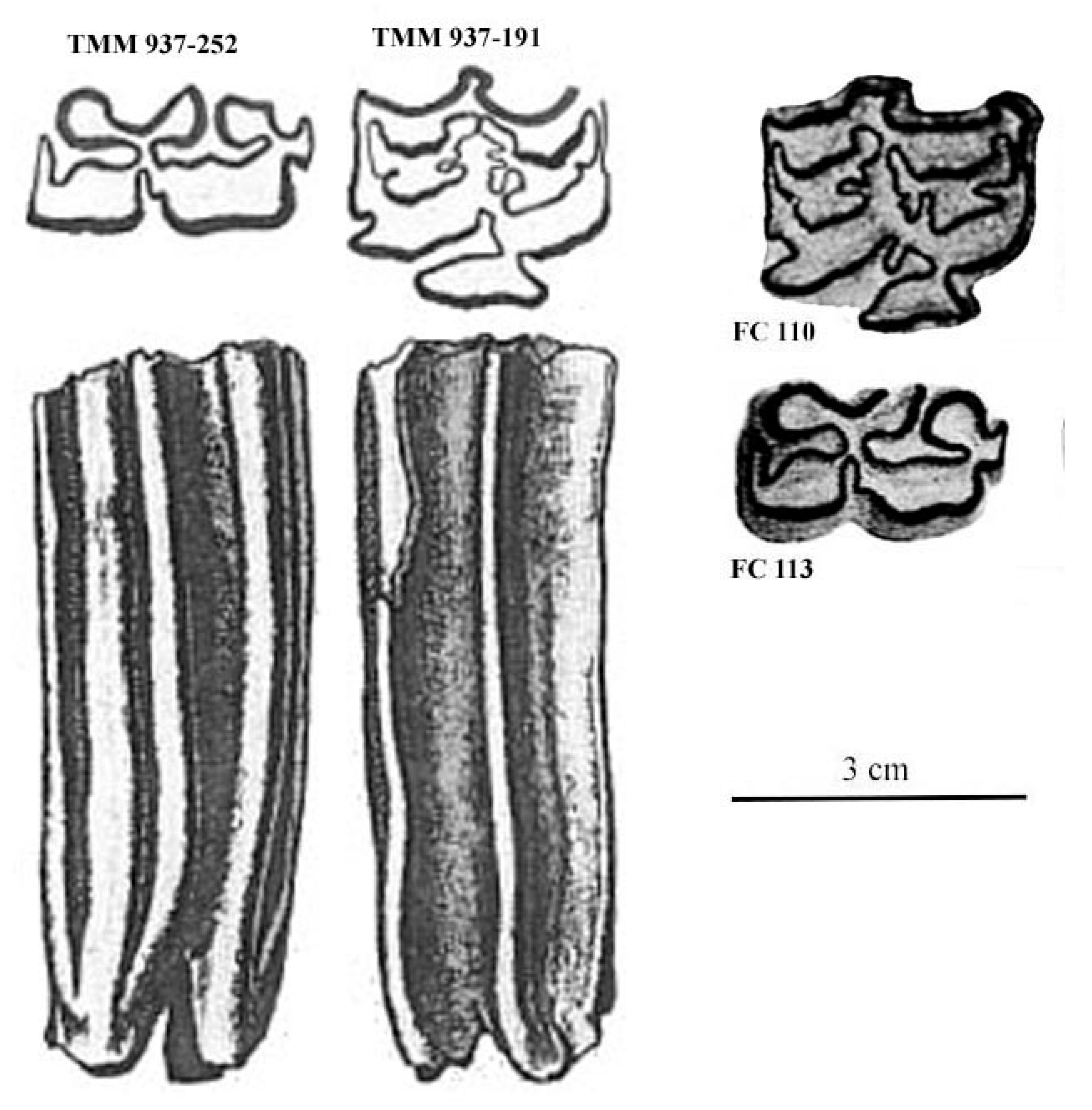





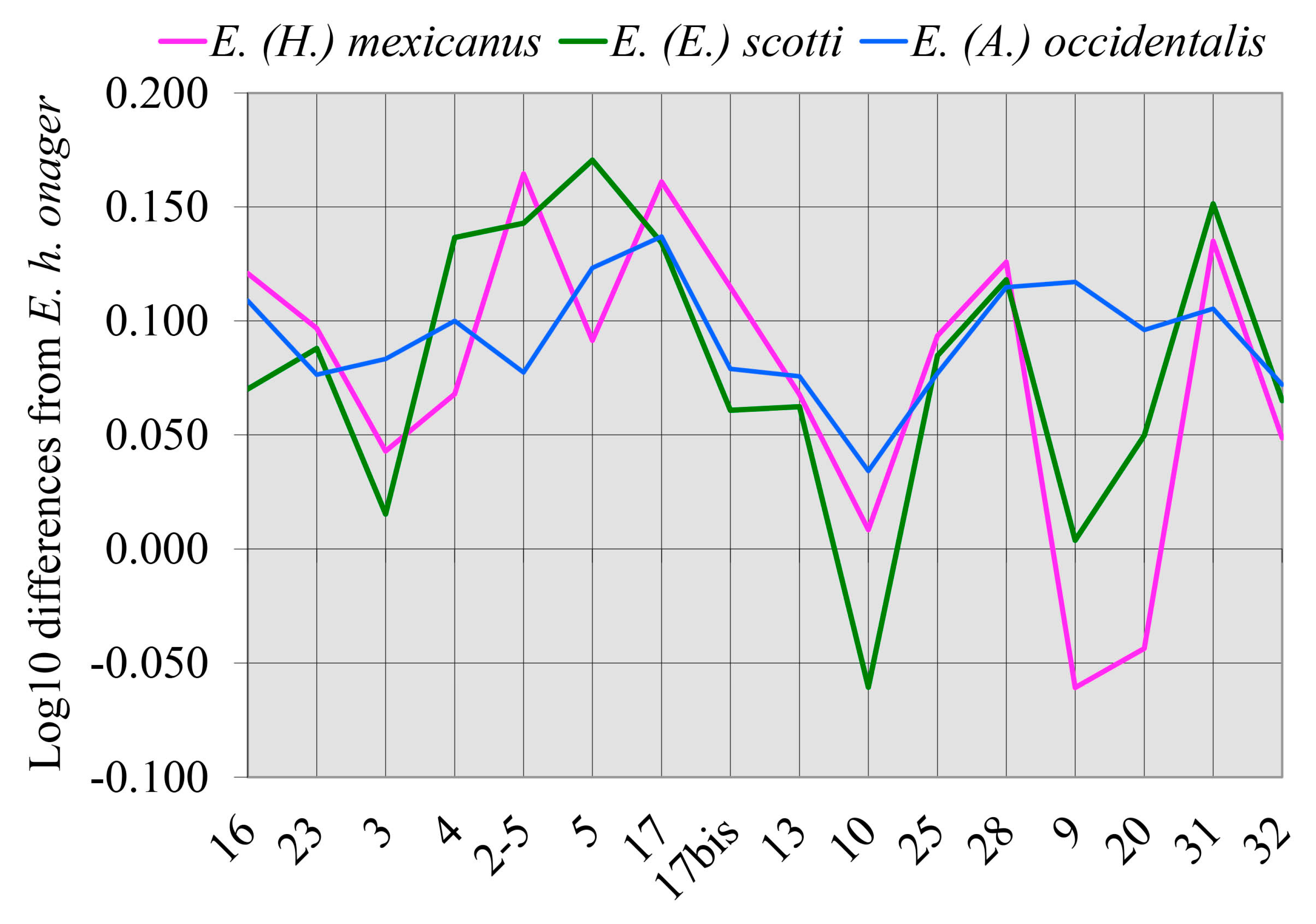

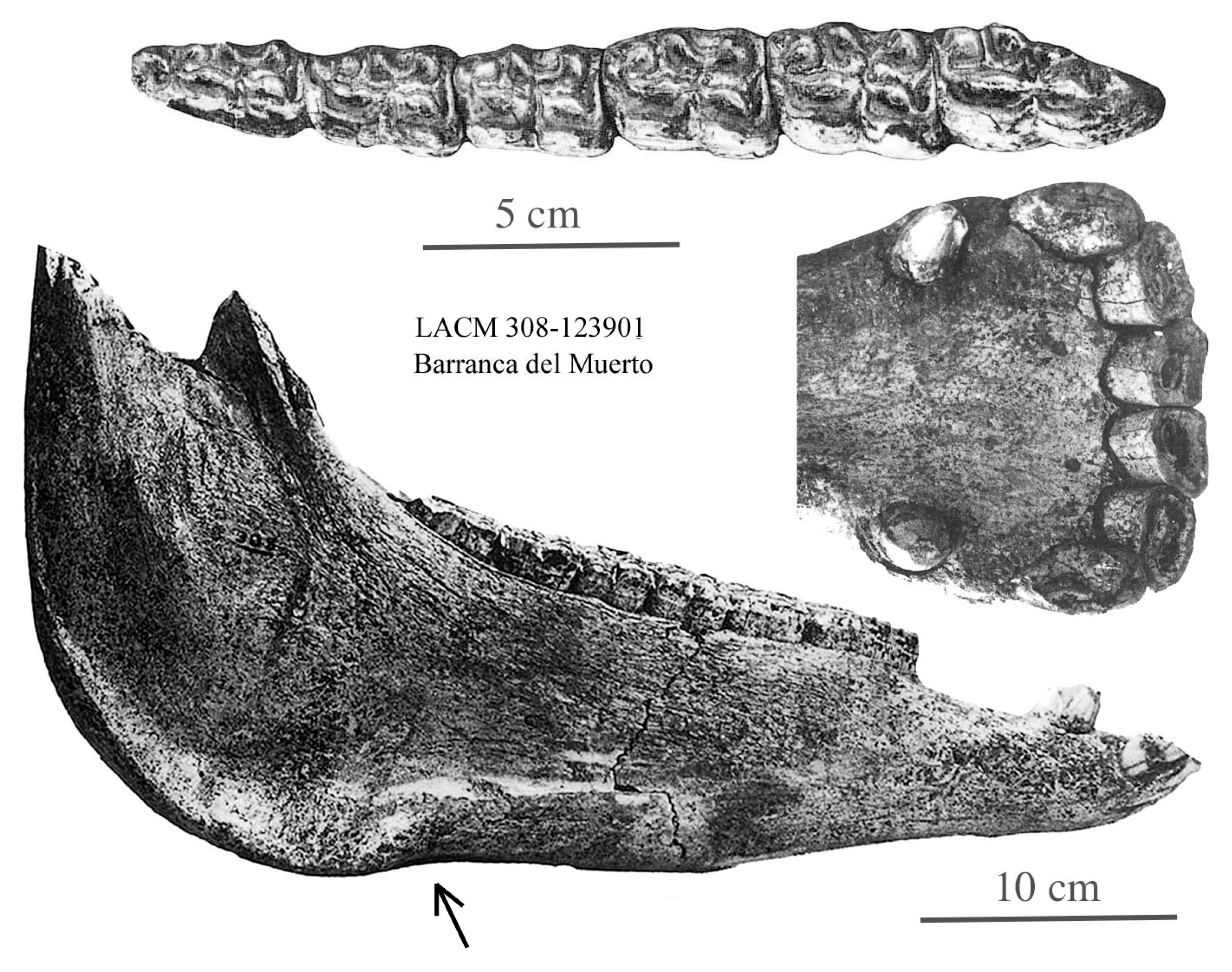
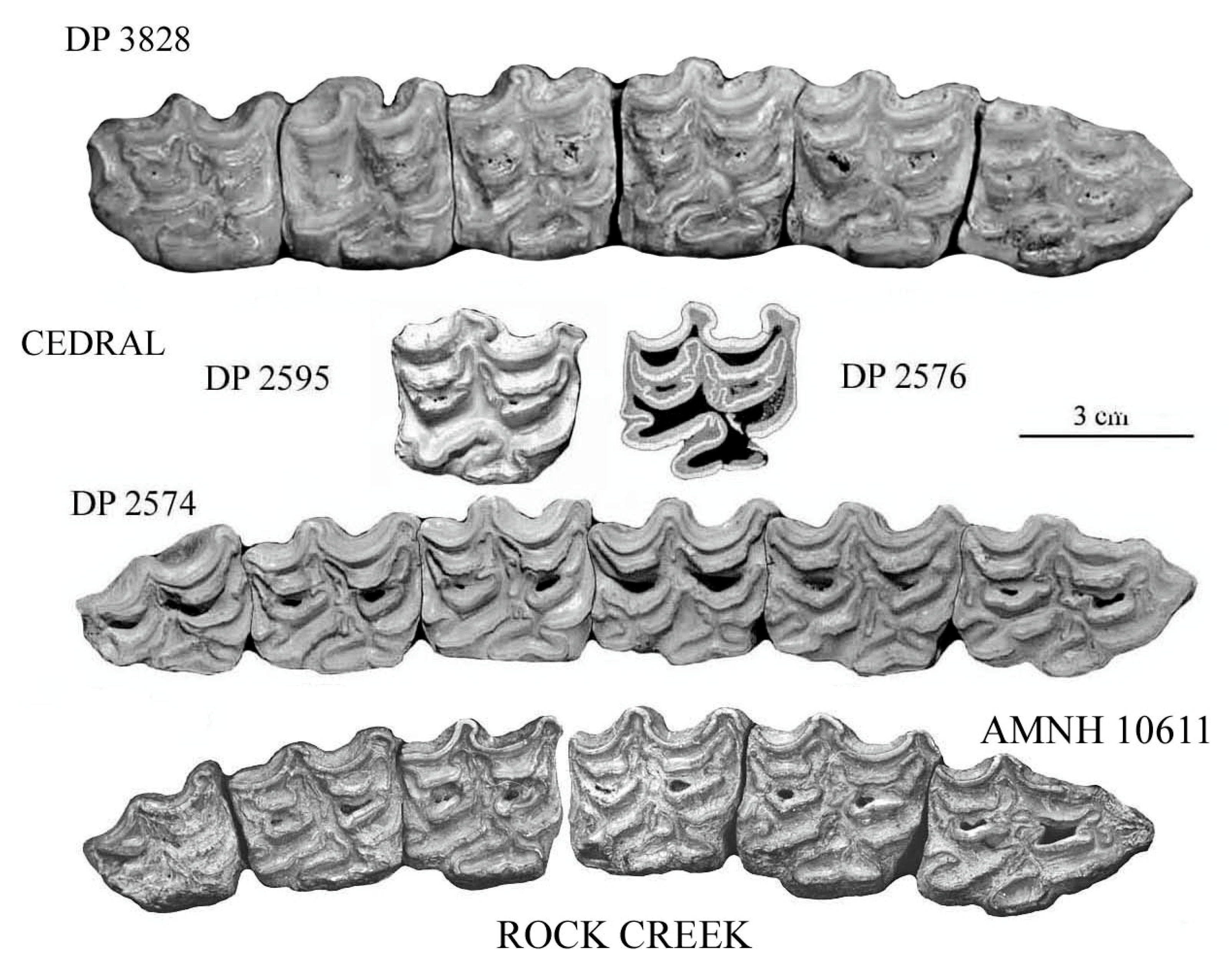

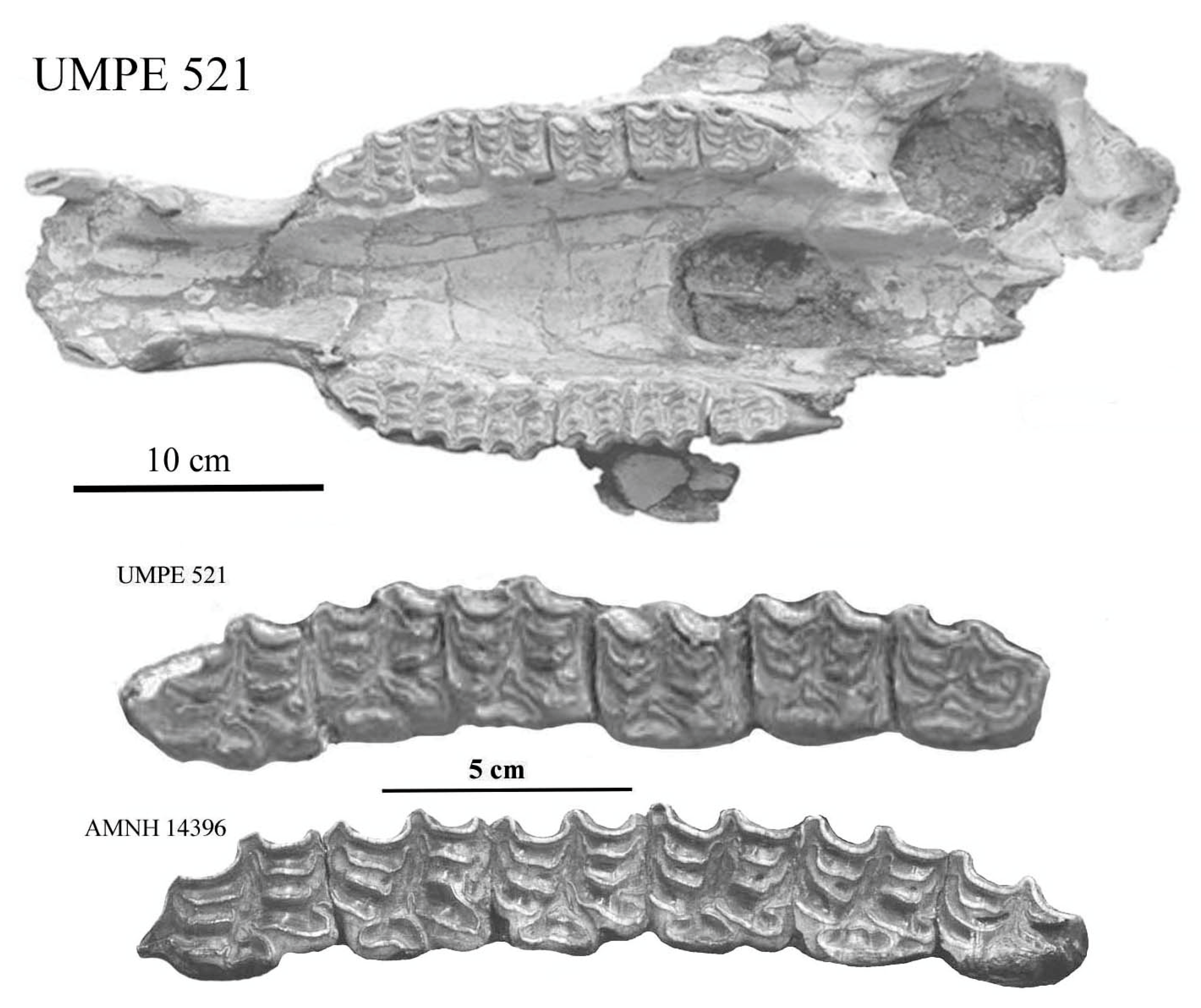
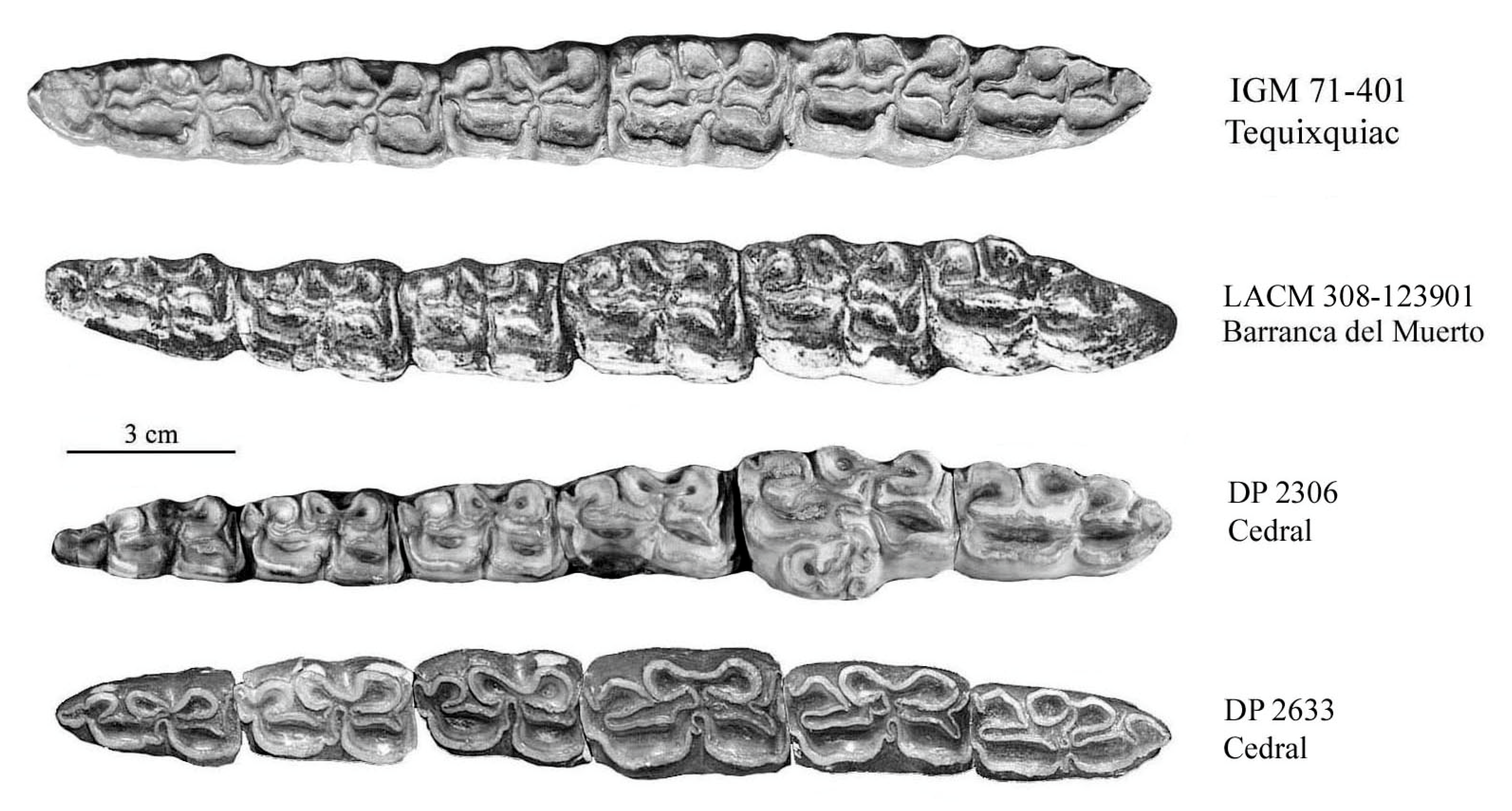
Disclaimer/Publisher’s Note: The statements, opinions and data contained in all publications are solely those of the individual author(s) and contributor(s) and not of MDPI and/or the editor(s). MDPI and/or the editor(s) disclaim responsibility for any injury to people or property resulting from any ideas, methods, instructions or products referred to in the content. |
© 2025 by the authors. Licensee MDPI, Basel, Switzerland. This article is an open access article distributed under the terms and conditions of the Creative Commons Attribution (CC BY) license (https://creativecommons.org/licenses/by/4.0/).
Share and Cite
Eisenmann, V.; Barrón-Ortiz, C.I.; Montellano-Ballesteros, M. North American Caballines and Amerhippines of the Past 1 Million Years (Part 1). Quaternary 2025, 8, 68. https://doi.org/10.3390/quat8040068
Eisenmann V, Barrón-Ortiz CI, Montellano-Ballesteros M. North American Caballines and Amerhippines of the Past 1 Million Years (Part 1). Quaternary. 2025; 8(4):68. https://doi.org/10.3390/quat8040068
Chicago/Turabian StyleEisenmann, Véra, Christina I. Barrón-Ortiz, and Marisol Montellano-Ballesteros. 2025. "North American Caballines and Amerhippines of the Past 1 Million Years (Part 1)" Quaternary 8, no. 4: 68. https://doi.org/10.3390/quat8040068
APA StyleEisenmann, V., Barrón-Ortiz, C. I., & Montellano-Ballesteros, M. (2025). North American Caballines and Amerhippines of the Past 1 Million Years (Part 1). Quaternary, 8(4), 68. https://doi.org/10.3390/quat8040068




